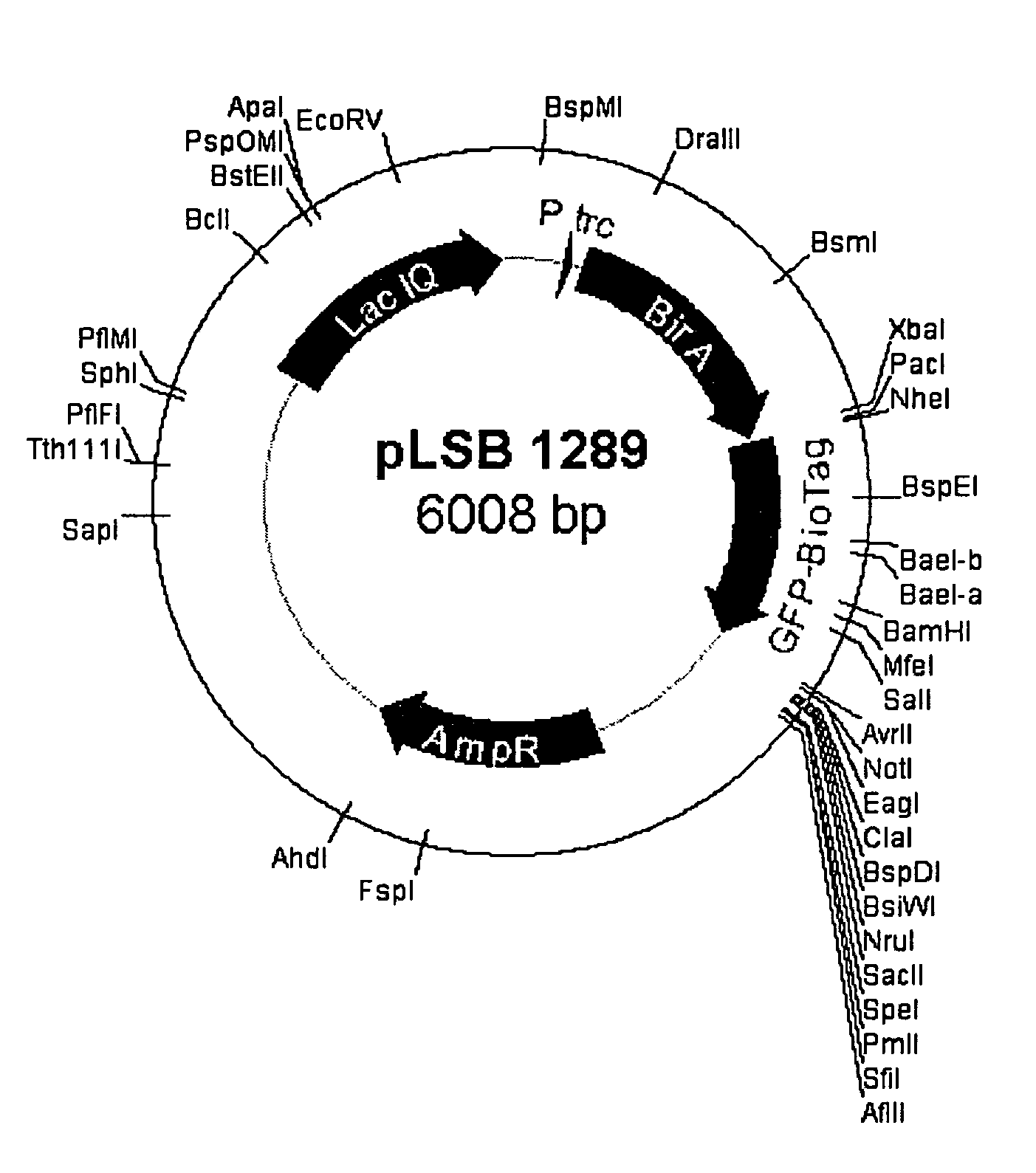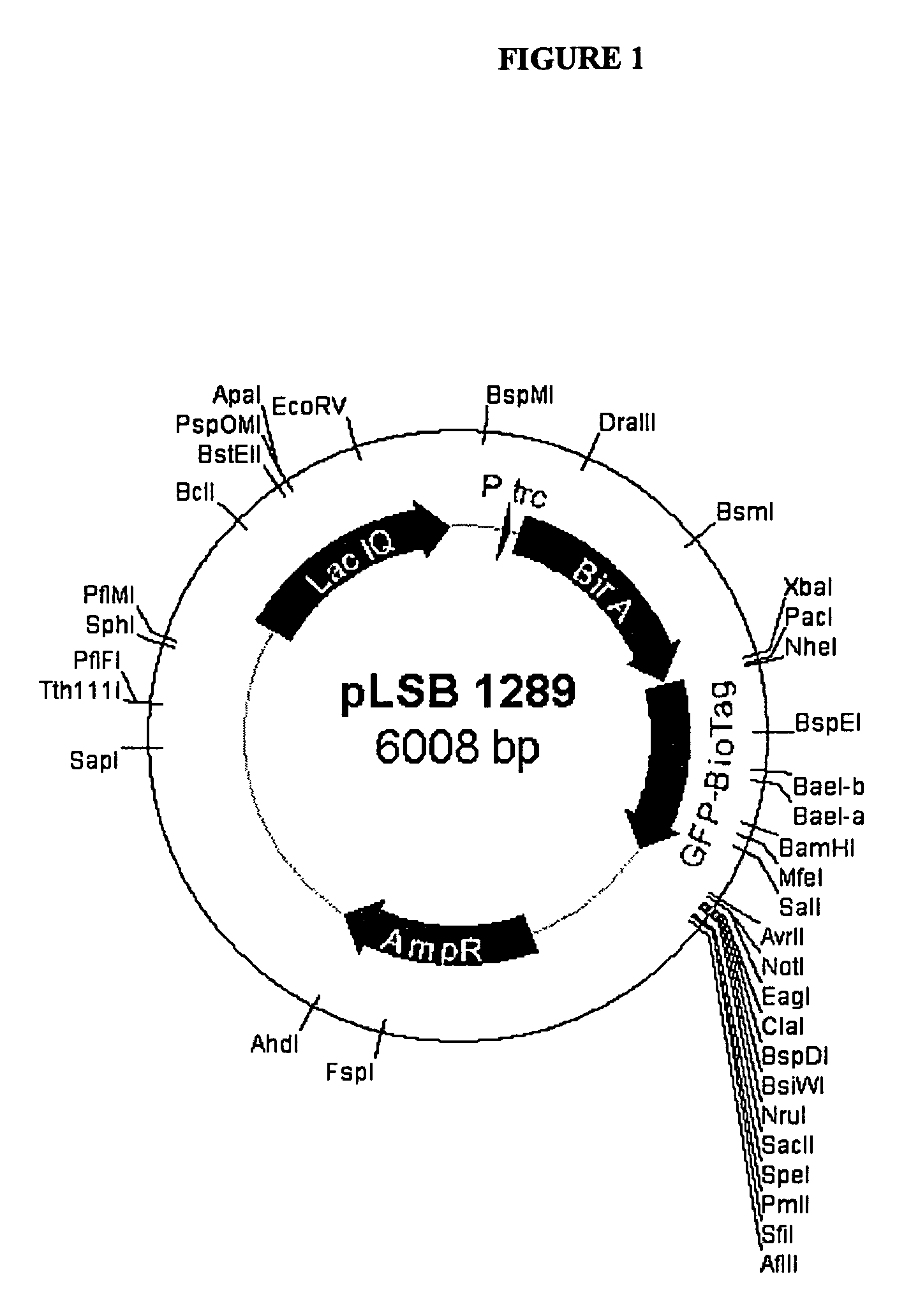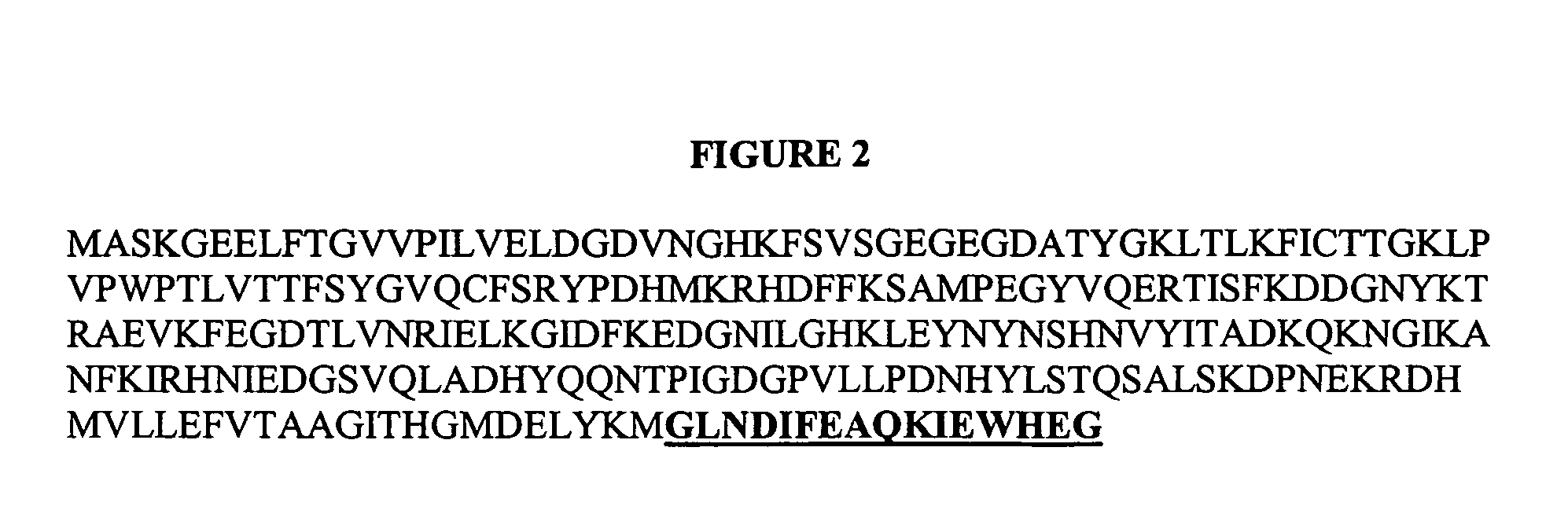Modified tobacco mosaic virus particles as scaffolds for display of protein antigens for vaccine applications
- Summary
- Abstract
- Description
- Claims
- Application Information
AI Technical Summary
Benefits of technology
Problems solved by technology
Method used
Image
Examples
example 1
Production of Biotinylated GFP in E. coli
[0093]Biotinylation is a post translational modification of some proteins, carried out by a biotin protein ligase enzyme. Typically less than 6 different protein species are biotinylated in any one cell type, making this a relatively rare post translational modification. Biotin protein ligase attaches a biotin to the epsilon amino group of specific lysine (K) residues.
[0094]The E. coli BirA gene encodes for a biotin protein ligase enzyme. By screening a peptide library for the ability to act as a substrate for the E. coli birA enzyme, researchers have identified a 16 aa peptide which can be biotinylated by birA. This 16 aa tag is referred to as the “aviTag” sequence (GLNDIFEAQKIEWHEG). Proteins with this tag, at either the N or C terminus, can be biotinylated by birA.
[0095]The bacterial expression vector pSE380 (invitrogen) was modified to express both the E. coli Bir A (biotin protein ligase enzyme) and a GFP-aviTag fusion protein to genera...
example 2
Production of Biotinylated TMV U5 CP in Plants
Procedures:
[0099]PCR Amplification of E. coli BirA Gene:
[0100]E. coli genomic DNA was purified from DH5a E. coli using Qiagen DNeasy kit according to manufacturers instructions. Five nanograms of purified genomic E. coli DNA was used in a 50 ul PCR reaction with oligos JAL 604 Forward oligo seq (TTGTTAATTAACCATGGGAAAGGATAACACCGTGCCACTGAAATTG) and JAL 605 Reverse oligo sequence: (CTTTCTAGATTATTTTTCTGCACTACGCAGGGATATTTCA) and Pfu Turbo DNA polymerase, for 30 cycles of 94 C 30 seconds, 54 C1 min, 72 C1 min. The approximately 1 kb PCR product was digested with PacI and XbaI and cloned into PacI-AvrII digested p30B GFP derivative.
Construction of a U5CP-AviTag Fusion.
[0101]Initial attempts to fuse the avitag peptide sequence to the N-terminus of the U5 CP resulted in a fusion protein that did not accumulate well in plants. Therefore the avitag was also fused to the C-terminus of the U5 CP.
[0102]Using PCR based insertional mutagenesis the codin...
example 3
Production of Biotinylated Proteins In Vitro
Quantitative Biotinylation of TMV Particles In Vitro.
[0105]T7, capped transcripts from pLSB 1295.4 DNA sample were used to inoculate N. benthamiana plants. Virus was purified from infected tissue using pH 5.0 acetate buffer, 50 C heat treatment followed by PEG / NaCl precipitation according to standard purification conditions.
[0106]Non-native U1-CP amino acids are in bold.
MADFKSYSITTPSQFVFLSSAWADPIELINLCTNALGNQFQTQQARTVVQRQFSEVWKPSPQVTVRFPDSDFKVYRYNAVLDPLVTALLGAFDTRNRIIEVENQANPTTAETLDATRRVDDATVAIRSAINNLIVELIRGTGSYNRSSFESSSGLVWTSGPAT
[0107]The reagent NHS-PEO4-Biotin (Pierce Cat # 21329) reacts with amine groups (e.g. lysine residues) and can be used to conjugate biotin to proteins. Quantitative biotinylation of TMV 1295.4 (see Table 1) could be obtained by preparing 400 ug of purified 1295.4 virus in 350 ul of 50 mM phosphate buffer (pH 7.0), and using this solution to resuspend 0.2 mg of “No-Weigh” NHS-PEO4-Biotin. Biotinylation reaction was...
PUM
| Property | Measurement | Unit |
|---|---|---|
| Fraction | aaaaa | aaaaa |
| Volume | aaaaa | aaaaa |
| Volume | aaaaa | aaaaa |
Abstract
Description
Claims
Application Information
 Login to View More
Login to View More - R&D
- Intellectual Property
- Life Sciences
- Materials
- Tech Scout
- Unparalleled Data Quality
- Higher Quality Content
- 60% Fewer Hallucinations
Browse by: Latest US Patents, China's latest patents, Technical Efficacy Thesaurus, Application Domain, Technology Topic, Popular Technical Reports.
© 2025 PatSnap. All rights reserved.Legal|Privacy policy|Modern Slavery Act Transparency Statement|Sitemap|About US| Contact US: help@patsnap.com



